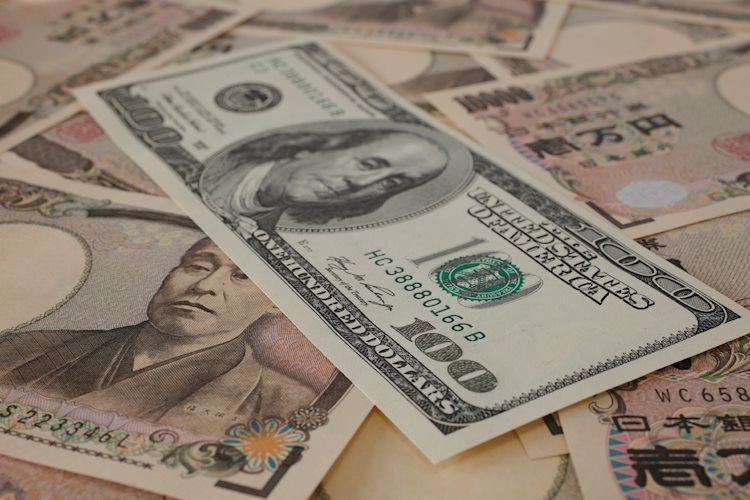- USD/JPY rises up to within a hair’s breadth of 152.00 after comments from BoJ governor Ueda.
- His views suggest the BoJ is not in a hurry to raise interest rates, reducing the attractiveness of the Yen.
- Analysts are bullish USD/JPY despite the threat of intervention as US-Japan interest rates continue to diverge.
USD/JPY is edging higher into the 151.90s on Tuesday. The latest move comes after a speech by the Governor of the Bank of Japan (BoJ) Kazuo Ueda in which he suggested that any future interest rate hikes – a key FX-market driver – would be highly dependent on incoming data.
Prior to his comments, views had been mixed about the likelihood of the BoJ hiking interest rates in the future. Some analysts saw more interest-rate hikes on the horizon given that core inflation in Japan has remained above the BoJ’s target of 2.0% for 23 consecutive months.
Others have remained more circumspect, pointing to the fact that in Japan where deflation has ravaged for decades, inflation is actually seen as a positive and something to be fostered.
In his speech Ueda seemed to validate those who expect the BoJ to keep interest rates indefinitely low, by introducing doubt about the imminence of future hikes.
Inflation still below target, says Ueda
According to Ueda, “Trend Inflation”, a somewhat tricky gauge that differs from official headline and core measures, is still running below 2.0% and likely to do so for quite some time. A change in the BoJ’s policy stance, therefore, would be dependent on this measure of inflation rising.
“If trend inflation accelerates toward our 2% inflation target, it becomes possible to reduce degree of monetary stimulus somewhat,” said Ueda in his speech on Tuesday.
The two factors the BoJ would be closely monitoring in regards to inflationary pressures would be wage inflation and services inflation, Ueda added.
USD/JPY trading at historic highs
USD/JPY has been trading at historic highs due to the difference in interest rates in the two countries. In the US they are above 5.0% whereas in Japan they remain at around 0.0%.
The difference is significant as it favors the USD over the JPY since investors can reap higher interest payments simply by parking their money in the US.
The effect of the divergence was highlighted by Japanese Current Account data out on Monday, which showed a lower-than-expected level of net inflows into Japan in February. A surplus of over 3 billion JPY had been expected when actually the figure came out at 2.6 billion JPY.
Doubts over Federal Reserve plans
The effect of interest-rate divergence on USD/JPY has further been exacerbated by changing expectations of monetary policy in the US.
Whereas the US Federal Reserve (Fed) had expected to make three 0.25% reductions in interest rates in 2024 the start of the year, the persistence of stubbornly high inflation has led many to doubt this will be the case.
Strong US labor market data on Friday and an unexpected fall in the Unemployment Rate, have further suggested that inflation is likely to remain sticky as more workers earning are likely to also continue spending.
A key macroeconomic release on the calendar this week will be US Consumer Price Index (CPI) data out on Wednesday. If the data shows a rise above expectations it will further reduce the probability that the Fed will cut interest rates as much as previously expected.
The persistence of higher interest rates in the US and lower interest rates in Japan are likely to maintain upside pressure on USD/JPY.
Intervention Fears
The case of USD/JPY is further complicated by the Japanese government and BoJ’s habit of directly intervening in foreign exchange markets to prop up the Yen.
A quick glance at the charts will immediately suggest to the observer that the current level in the 151s is a level that has rejected price multiple times in the past – both in 2022, 2023 and now again in 2024. This is no coincidence.
The Japanese authorities have repeatedly said they will not tolerate the Yen weakening above this level as it harms businesses. So they tend to intervene at around the 150-152 band to push the exchange rate lower.
On Tuesday the Japanese Finance Minister Shunichi Suzuki said the authorities would not rule out any measures in dealing with excessive Yen moves, repeating warnings made in his previous statements, according to TradingEconomics.
This has been interpreted by markets as a verbal intervention. It raises the risk of a physical intervention, however, if the USD/JPY tests 152 or higher.
USD/JPY to 160, say analysts
Intervention can only achieve so much, however, and strategists at Bank of America Merill Lynch (BofA) recently said in a note that if the fundamentals continue to show such a wide interest-rate divergence, USD/JPY is likely to break higher regardless of the authorities’ attempts to intervene, and potentially make it to 160.
Such a scenario, however, would be dependent on the Fed scraping its plans for cutting interest rates in 2024, something currently not envisaged.
A combination of the BoJ holding back from raising interest rates in 2024 and the Fed delaying its plans to cut rates could continue exerting upside pressure on the pair.
A similar conclusion was reached by analysts at Brown Brothers Harriman (BBH) in a recent note in which they said “It’s only a matter of time before USD/JPY rises”. This, they put down to a combination of the BoJ’s very gradual attempts to raise interest rates and the Fed’s likely delay in making interest rate cuts.
(This story was corrected on April 9 at 11:22 GMT to say that the USD/JPY is edging higher into the 151.90s, not 101.90s).
